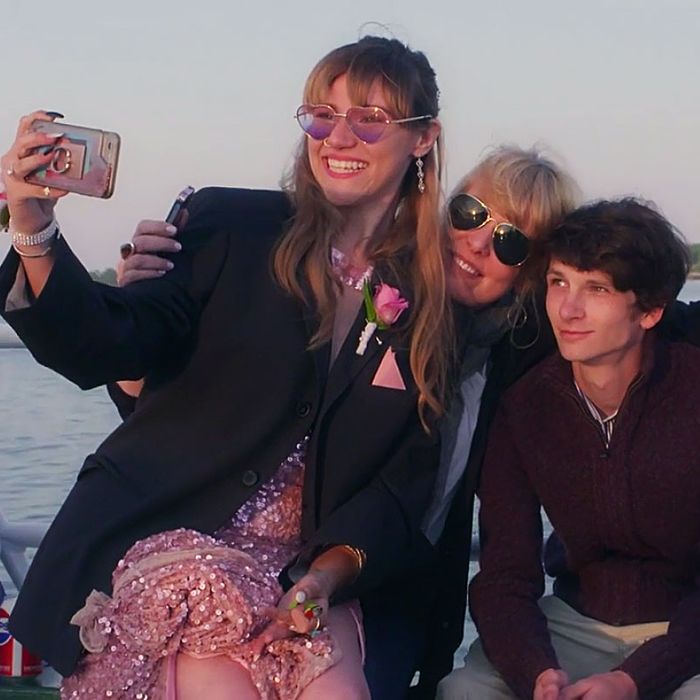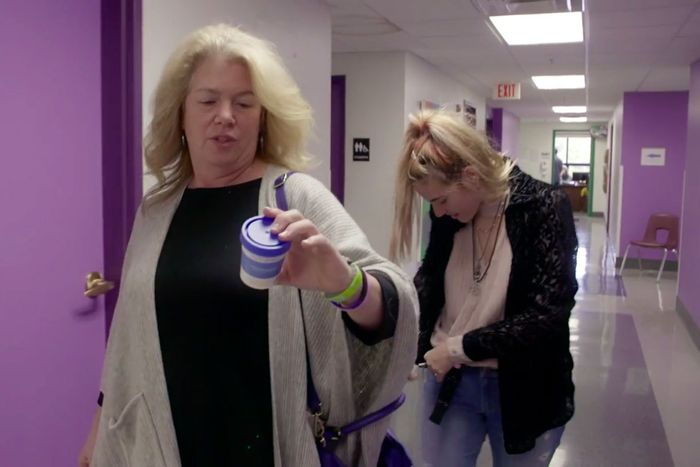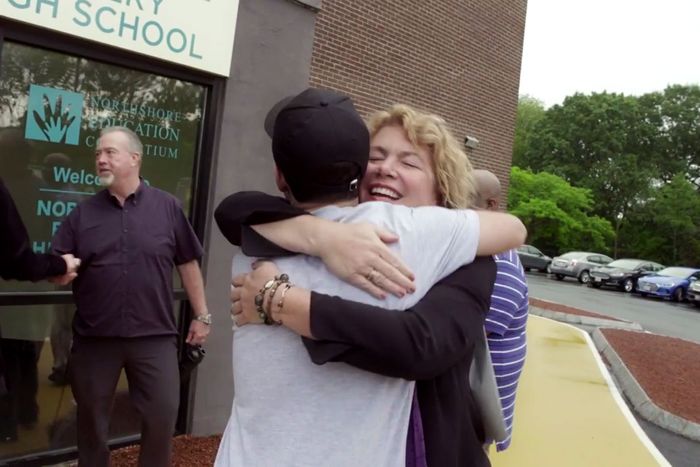
Northshore Recovery High School, a public high school in Beverly, Massachusetts, is at once self-explanatory ÔÇö a high school for students grappling with addiction, with their eyes on a sober future ÔÇö and totally baffling. ItÔÇÖs a what? And it works how? Since 2006, when Michelle Lipinski, the founder and principal of Recovery, started her school, she has done a lot of public speaking, including a 2012 Ted Talk, trying to explain her mission to a nation beset by addiction. She doesnÔÇÖt get what everybody doesnÔÇÖt get.
ÔÇ£God as my witness, I really thought that everybody does this!ÔÇØ she told Vulture. ÔÇ£And now IÔÇÖm learning: They donÔÇÖt. Why donÔÇÖt people just go 110 percent and do whatÔÇÖs right for these children? For me, itÔÇÖs intuitive. ItÔÇÖs what needs to get done and you get it done.ÔÇØ
In 16 and Recovering, the new MTV docuseries set at her high school, Lipinski lays out the stakes in her signature tone: compassionate and matter-of-fact, Tami Taylor by way of the T. ÔÇ£WeÔÇÖre going to lose a generation,ÔÇØ she says, ÔÇ£because we treat them like theyÔÇÖre bad when theyÔÇÖre sick.ÔÇØ
As the series unfolds, viewers meet teenagers who speak about their circumstances with a stunning clarity and bruising self-awareness. ÔÇ£IÔÇÖm either going to end up dead, in jail, institutions, or sober,ÔÇØ says Sam, a Recovery student. ÔÇ£But I really donÔÇÖt want to be sober.ÔÇØ Alba, a self-described unofficial ÔÇ£cheerleaderÔÇØ of Recovery High (as Jerry is to Cheer, so Alba is to 16 and Recovering), says that when sheÔÇÖs going through a depressive episode, ÔÇ£You can cheer other people up, but you canÔÇÖt cheer yourself up.ÔÇØ ÔÇ£IÔÇÖm an addict,ÔÇØ she says later. ÔÇ£But I wanna not kill myself and learn how to be alive.ÔÇØ
The school is one kind of experiment: What happens when you reject the conventional American strategy on combating substance abuse ÔÇö to declare war on drugs and treat addicts as criminals ÔÇö and the conventional wisdom about what ÔÇ£troubledÔÇØ kids need to thrive in an academic environment: uniforms, militaristic discipline, zero-tolerance policies for minor infractions? Recovery offers an alternative way: A school with a relapse policy, counseling on demand, hugs all the time. It is a place where a positive result on a drug test (they are administered often and at random) is not the end of oneÔÇÖs education but the beginning of a conversation. As someone who attended a public high school where students were regularly reprimanded for, among other supposedly education-derailing offenses, wearing tank tops whose straps were not three fingers wide, the practices of a place like Recovery feel so accepting as to be almost anarchic.
The show is a kind of experiment, too. MTV wants to be where the young people are, which requires both (belatedly) getting onboard with the biggest band on the face of the Earth and addressing the serious issues teenagers face. In 2020, that means covering the opioid crisis, which kills 145 Americans every day. A Centers for Disease Control and Prevention study from 2018 found that opioid-overdose death rates among U.S. children and teenagers have tripled since 2000, with the highest risk hitting older teenagers, who made up 88 percent of the deaths in the study.
When 16 and Pregnant premiered on MTV in 2009, its aim was to provide an unvarnished and compelling look at teen pregnancy, which at the time was already on the decline in the U.S. There was and remains plenty of side-eye about the show and its spinoff/sequel, Teen Mom: That it glamorized teen pregnancy; that its cast was put on display to be gawked at, not empathized with, by the audience. Its starsÔÇÖ faces could frequently be seen on salacious tabloid covers. It was, at times, unclear where exactly the series fell on the spectrum spanning education, entertainment, and exploitation.
We are not unaware of the idea that portraying someone on television can lead to a romanticization of their situation, said Benjamin Hurvitz, an executive producer on 16 and Recovering who oversees the Teen Mom franchise. But we do believe that if you tell a story without all the artifice  it really invites an audience in  Were very careful behind the scenes to show these stories with a lot of intention.
By the time 16 and Pregnant went off the air, MTV had some promising data on its side: A media study from 2014 that combined viewership and birth data found that teenagers who watched 16 and Pregnant would often follow the episodes by going online and searching for information about birth control and abortion. These findings linked 16 and Pregnant to a 5.7 percent reduction in teen births, one-third of the total decline.
Hurvitz pointed to the website MTV is rolling out alongside 16 and Recovering in collaboration with experts on the subject, including the National Institute on Drug Abuse, as a sign that the series is mission-driven and the network is taking its social responsibility seriously. ÔÇ£I think back in the day when 16 and Pregnant was conceived, the idea wasnÔÇÖt necessarily from the get-go to effect change in teenage pregnancy. ThatÔÇÖs not how creative people approach social-justice issues,ÔÇØ he said. ÔÇ£But we never shied away from telling real and authentic stories of our audiences and what was affecting them most.ÔÇØ
ÔÇ£You can show us in the light of recovery and hope, or you can show us looking like a disaster.ÔÇØ
Lily Neumeyer, MTVÔÇÖs executive vice-president of development, started her career at the network years ago, co-creating and executive-producing a very different type of show about high schoolers: My Super Sweet 16. She now oversees unscripted development for the whole phalanx of Viacom brands ÔÇö MTV, VH1, CMT, and Logo ÔÇö and had been searching for a few years for content on the opioid crisis when, in 2019, Steve Liss walked into her office.
Liss, a former staff photographer at Time magazine and documentary filmmaker, had spent the 2017ÔÇô2018 school year shooting at Northshore Recovery High School. HeÔÇÖs also an associate professor at Endicott College, and a former student of his had shot a short film on mental health and substance abuse at Recovery that involved students, which ÔÇ£was a really good experience,ÔÇØ Lipinski said. ÔÇ£It was done incredibly tastefully, and the students felt heard.ÔÇØ When Liss reached out to Lipinski about shooting a longer feature about the school, she was inclined to say yes, hoping that perhaps his film would be something she could take around with her to speaking gigs and, she said, ÔÇ£help me sound like IÔÇÖm not so far out on the fringe of education.ÔÇØ Parents, staff, and students were all onboard, too.
From the jump, Liss and Lipinski agreed on a few no-go zones: No depicting anyone using, buying, or selling drugs. ÔÇ£ItÔÇÖd be very easy in a story like this to go for the jugular, the sensational, the low-hanging fruit of those kinds of visual clich├®s,ÔÇØ Liss told Vulture. ÔÇ£And I had no interest in that. WeÔÇÖre trying to put a human face on a problem that is so often misunderstood, and so often mischaracterized ÔǪ We talk the talk about, ÔÇÿOh, itÔÇÖs a disease,ÔÇÖ but we donÔÇÖt walk the walk. We still treat it like a moral failure.ÔÇØ
Lipinski trusted Liss enough to give him ÔÇ£full reign of my school,ÔÇØ she said. ÔÇ£I had no idea what he was filming all the day long. But we did have this trust between us that he wasnÔÇÖt going to exploit the children. And that is a big trust. ItÔÇÖs so easy to have that salacious story.ÔÇØ
Im sure theres stuff that happened that year that looks more like Jersey Shore than 16 and Pregnant, Lipinski added, laughing. That was where the trust came along  You can either show us in the light of recovery and hope, or you can show us looking like a disaster. Theres probably footage of every single one of my students in a really bad place.
ÔÇ£ThereÔÇÖs a fine line in a documentary between balancing the good youÔÇÖre trying to do with the vulnerability of those whose stories you undertake to tell, and thatÔÇÖs particularly true with young people,ÔÇØ said Liss. ÔÇ£These kids arenÔÇÖt a cast of characters. This isnÔÇÖt a reality show. This is a piece of journalism.ÔÇØ
Liss shopped the project, which hed envisioned as a feature film, to the usual suspects: Netflix, HBO, and all the rest, he said. But MTV was more enthusiastic about the project than anybody else, he said, and, more important to Liss, they had a track record for advocacy  I know the impact that MTV has had, particularly with young people. You can go all the way back to Rock the Vote or 16 and Pregnant and the measurable impact that they had with pregnancy and young people. He was impressed with MTVs plans for the website that would make the show into a campaign.
ÔÇ£This was about being a catalyst for discussion, and thatÔÇÖs what MTV does,ÔÇØ Liss said. ÔÇ£I wanted someplace that would be provocative, in the most positive sense of that word.ÔÇØ
From his hundreds of hours of footage, Liss gave Neumeyer about four minutes on which to base her decision. ÔÇ£The biggest thing that struck me from the footage was: I canÔÇÖt believe a place like this exists,ÔÇØ Neumeyer said. ÔÇ£And why arenÔÇÖt there other places like this?ÔÇØ
ÔÇ£The name was a source of concern.ÔÇØ
It was, Hurvitz said, ÔÇ£a little unusualÔÇØ for MTV to work this way ÔÇö with someone who had already shot the bulk of their material ÔÇö and early on, they didnÔÇÖt know what shape it would take: how many episodes, how many stories, what the MTV version of it would be. Eventually they settled on four episodes to air during September 2020, to coincide with National Recovery Month. The third episode airs tonight.
Liss ÔÇ£obviously didnÔÇÖt bring it to us as a 16 and,ÔÇØ Hurvitz said. ÔÇ£It wasnÔÇÖt something he would have thought of as a documentary filmmaker. But when we saw the footage and saw the raw and impactful storytelling of these portrayals of these students, we knew it would be a natural fit.ÔÇØ
Liss was initially apprehensive about his work being folded into the 16 and extended universe.┬áÔÇ£At first, the name was a source of concern to me,ÔÇØ he said. ÔÇ£But then I realized, we will live or die by our own merits, and our own content.ÔÇØ
For the Recovery High community, the news that MTV was interested was a major plot twist. ÔÇ£I was shocked in the beginning,ÔÇØ said Lipinski. ÔÇ£But the choice was, do we want to make this small indie film that maybe is something not too many people will see, and the kids who really need to see it wonÔÇÖt see it? For the reach, this is where it should be.ÔÇØ
Faith, whose senior year is covered in the show, had figured the documentary would land someplace with more of an educational lens: the History Channel, PBS. ÔÇ£When they said MTV, I was kind of nervous because of what MTV usually is: They exploit people, from what IÔÇÖve seen,ÔÇØ she told Vulture. But she trusted Liss, who assured the students that if they didnÔÇÖt like something, he would take it out or redo it.
Overall, ÔÇ£I have mixed feelings toward it [being on MTV],ÔÇØ Faith said. ÔÇ£I know MTV is 50/50 good/bad, [and] it depends on the person. But IÔÇÖm glad that such a big platform is able to show recovery in adolescents because I think people need that.ÔÇØ
The magnitude of attention the show will inevitably bring is ÔÇ£a little frightening,ÔÇØ Faith said. When we spoke a week before the premiere, sheÔÇÖd already gotten a bunch of messages just from people whoÔÇÖve seen the trailer. But sheÔÇÖs at a point where that level of exposure doesnÔÇÖt rattle her too much. ÔÇ£As long as it makes at least one person realize theyÔÇÖre worthy of sobriety, IÔÇÖm okay.ÔÇØ
Hurvitz says that Liss got consent from the kids and, in some cases, their parents when filming began, and that when MTV came onboard, they got an additional round. ÔÇ£Almost without exception, they have been most interested in telling their true stories in what happened to them over that year than trying to change anything. Most of the instances where we took something out was because we were uncomfortable with it.ÔÇØ
Asked about the risk for exploitation when dealing with a population this young, particularly given the nature of their lives ÔÇö the show includes scenes in which students, for instance, arrive at school too high to stay there ÔÇö Hurvitz said, ÔÇ£I feel very strongly about not exploiting their stories. I canÔÇÖt say enough how much we thought about that. We really arenÔÇÖt trying to glamorize these kids.ÔÇØ
Hurvitz adds, ÔÇ£We werenÔÇÖt sure that we were going to make participants in this doc series available to speak with reporters. And it was really them who came to us after we met with them and talked extensively about the impact of social media and what can happen when trolls engage online ÔǪ We had these calls where they kept saying, ÔÇÿWe are not ashamed of this; we donÔÇÖt want to be hidden away; we want to talk; we want to tell our stories.ÔÇÖÔÇØ
For anyone expecting something more in that MTV ÔÇ£realityÔÇØ vein ÔÇö producer-staged screaming matches, scripted mascara tears ÔÇö 16 and Recovering will surprise you. ÔÇ£This isnÔÇÖt pretend,ÔÇØ said Joe, who was a senior during filming. ÔÇ£This is breaking new ground for reality television, I feel like. This is the realest reality show there can be. ItÔÇÖs a whole new way of looking at addiction itself.ÔÇØ
┬áÔÇ£That is my normal.ÔÇØ
ÔÇ£It was the worst year of my life, that year,ÔÇØ Lipinski said. ÔÇ£Just so you know. You couldnÔÇÖt have picked a worse or better year to have filmed exactly what happened in my school. By the eighth death, we were like, ÔÇÿOh my God, you canÔÇÖt put this out there.ÔÇÖÔÇØ
But while past depictions of overdoses and drug use often placed the nexus of guilt and responsibility on the individual user ÔÇö see: Rachael Leigh Cook smashing the egg in the frying pan, admonishing stoners everywhere, ÔÇ£This is your brain on drugsÔÇØ ÔÇö 16 and Recovering takes a more expansive view, indicting the systems that profit from and perpetuate drug use, that fail to provide adequate care to those who need it. The mother of a student who died during filming says it plainly: ÔÇ£This system failed him at every turn.ÔÇØ
ÔÇ£The fact that the system that was supposed to help him stood in his way, placed barriers in his way, that was a terrible shock,ÔÇØ Liss said. ÔÇ£And I should know better. I know the system is problematic. But to see it happen before my eyes, that was a surprise. It wasnÔÇÖt the drugs that killed him. It was the system that killed him.ÔÇØ
Hurvitz noted they had hours and hours of footage of different memorials and the studentÔÇÖs funeral, and they had to be mindful not to ÔÇ£overmemorialize.ÔÇØ ÔÇ£That can lead to people looking at that and saying, ÔÇÿI wish people cared about me that way,ÔÇÖ and thatÔÇÖs a dangerous thing,ÔÇØ he said. ÔÇ£I think 13 Reasons Why fell into that a little bit.ÔÇØ
Faith says the only time she remembers asking Liss to stop shooting was when she found out about the death of a friend of hers, a graduate of Recovery who was interning at the school. ÔÇ£I told him to turn the camera off, and he didnÔÇÖt listen in that moment. I think he really wanted to get the emotion of it,ÔÇØ she said. ÔÇ£And I screamed at him because I really donÔÇÖt want to feel like I have to protect myself when IÔÇÖm trying to grieve.ÔÇØ
At the same time, sheÔÇÖs grateful her experiences with her friends who are no longer here were captured on film by Liss. ÔÇ£The good parts. Because they were all so bright and loving and kind, that [itÔÇÖs good] being able to just see them and hear their voice sometimes.ÔÇØ
ÔÇ£ItÔÇÖs so weird,ÔÇØ Faith reflected. ÔÇ£Because the majority of my high-school experience, there was a camera in my face. But I wasnÔÇÖt going to get the normal high-school experience anyway, because I went to Recovery High School. For me, that is my normal.ÔÇØ



